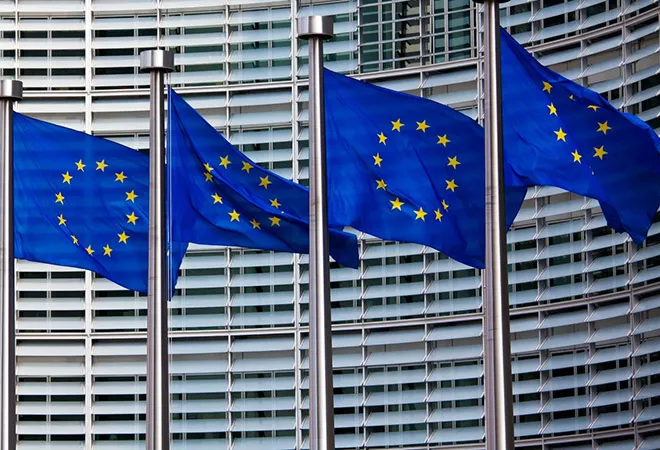-
CENTRES
Progammes & Centres
Location
After seven years of negotiations, the new pact has taken a decisive step towards a modernisation of the EU’s rulebook for asylum and migration

Following the Commission’s proposal in 2016 to reform the European Union’s (EU) Common Asylum Policy (of 1999) and its 2020 New Pact on Migration and Asylum, the EU’s Interior Ministers in June 2023 finally endorsed a negotiating position on asylum procedure regulation and the asylum and migration management regulation. After seven years of protracted negotiations and discussions, the new pact has been declared a “decisive step towards a modernisation of the EU’s rulebook for asylum and migration.” This article analyses the key aspects of this new migration deal and provides an overall assessment.
Learning from the experiences of the 2015-16 migration crisis, the EU has been discussing and implementing several measures to control migration to the continent and improve its external border. While the number of migrants arriving in Europe has reduced from 389,976 in 2016 to 189,620 in 2022, the number of asylum seekers has remained relatively high—with the Union receiving over 962,160 applications in 2022. These high numbers have made migration and asylum a political and potentially polarising issue in European politics.
After seven years of protracted negotiations and discussions, the new pact has been declared a “decisive step towards a modernisation of the EU’s rulebook for asylum and migration.”
The current deal aims to streamline the pressures of migration and asylum procedures and hopes to create an equitable and workable balance between the frontline states such as Italy, Greece, Spain, and other Northern and Central member states. Four key features of the deal include:
Since 2015-16, the EU has come under tremendous pressure to formulate a comprehensive policy outlook for migration and asylum. It has taken a two-pronged approach to the issue—first, it has tightened its external borders and established agreements with countries like Türkiye and Libya to regulate and reduce irregular migration. Second, internally it has put in place several policy measures such as a fully-functional EU Asylum Agency, the Qualification Regulation, the EU Resettlement Framework, and adopted New Pact on Migration and Asylum in 2020.
The new deal was passed through a qualified majority voting (QMV) instead of unanimous voting—with countries like Bulgaria, Czech, Slovakia, Malta, and Lithuania abstaining from voting.
There is an understanding among the member states of the need to overhaul the migration and asylum system of the EU. While the Northern and Central states have been concerned regarding the secondary movement of migrants and asylum seekers, the Southern states have been under pressure due to increasing irregular movements. So far in 2023, a migration flow of 87,903 to Europe has been registered. While this migration deal has been cited as historic and, once passed, can change the way the EU has looked at and dealt with migration. However, the divisions are bound to appear as it focuses more on border protection and offshoring of asylum processes and very little on the solidarity that the frontline member states have been calling for for years. With the 2023 pact, the idea is to re-engage with the member states on the distribution of the asylum seekers and migrants evenly to not put pressure on the frontline states who have been overwhelmed as other member states have either refused to host migrants or are hesitant to admit a large number. These worries will remain as monitoring the movement of people, once they are within the free movement area of the EU, will emerge as a big challenge.
The voting patterns of the member states also highlighted the divisions over the policy. The new deal was passed through a qualified majority voting (QMV) instead of unanimous voting—with countries like Bulgaria, Czech, Slovakia, Malta, and Lithuania abstaining from voting. At the same time, Poland and Hungary rejected the pact. Frontline states like Italy and Greece voted in favour of the deal after substantial concessions. While the support for the deal hinges on the fact that it presents a middle-ground between offering aid to border states without forcing other members to take in more asylum seekers; however, its critiques point out that expanding the checks at the border would lead to an increase in the number of detention centres around the EU countries.
One of the biggest contentious points for both Poland and Hungary emerged to be the use of qualified voting instead of unanimity.
The deal also became a contentious issue at the EU Summit, where Poland and Hungary raised their concerns at the eleventh hour, thereby stalling the meeting agenda. One of the biggest contentious points for both Poland and Hungary emerged to be the use of qualified voting instead of unanimity. As described under the EU treaties, for legislation on migration and asylum, the use of a qualified voting system by the European Council is sufficient. However, Council has rarely followed through this process before. The use of QMV this time resulted in the inability of Warsaw and Budapest to use their veto as they have usually done before. However, they were able to get the “consensus” added to the conclusions of the EU Summit—a reference to the need for unanimity in future discussions.
There is no doubt that the deal has raised consternation in several member states, and the EU must brace itself for intensive push and pull on the issue. The deal is now to be debated in the Parliament with an expectation of its finalisation before the next EU Parliament elections in June 2024. There is no denying that this remains an uphill task for policymakers within a short timeline. What is certain is that the issue of migration will continue to dominate conversations within the member states and among the policymakers in the EU.
Ankita Dutta is a Fellow with the Strategic Studies Programme at Observer Research Foundation.
The views expressed above belong to the author(s). ORF research and analyses now available on Telegram! Click here to access our curated content — blogs, longforms and interviews.

Ankita Dutta was a Fellow with ORFs Strategic Studies Programme. Her research interests include European affairs and politics European Union and affairs Indian foreign policy ...
Read More +